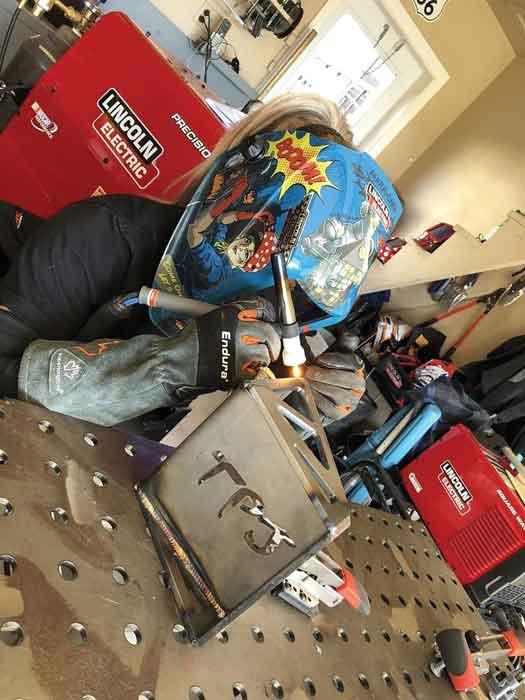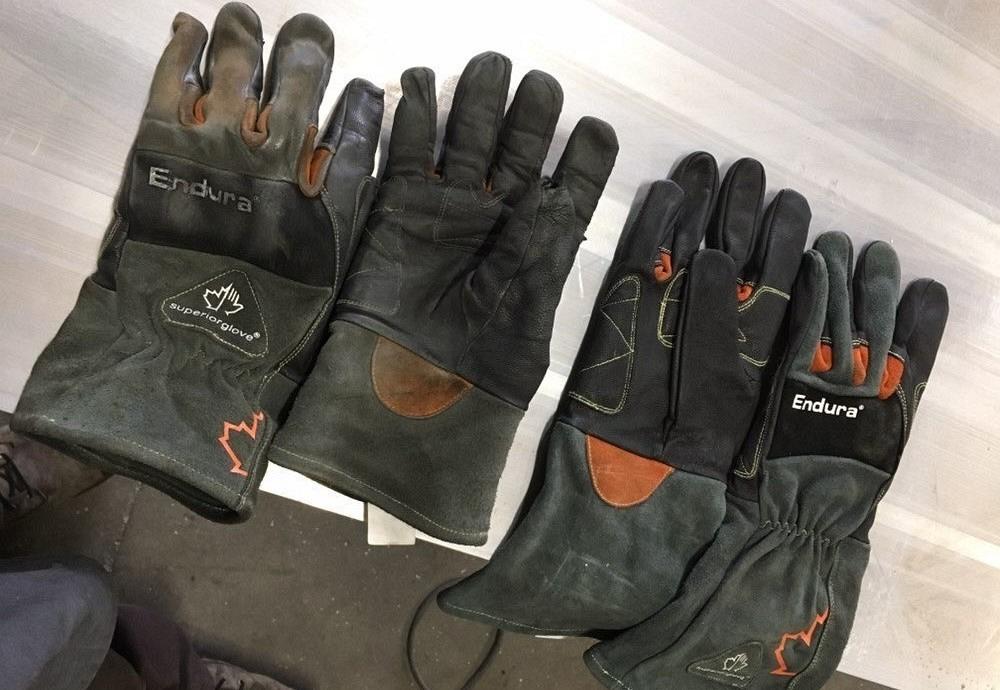Vice President
- FMA
- The Fabricator
- FABTECH
- Canadian Metalworking
Categories
- Additive Manufacturing
- Aluminum Welding
- Arc Welding
- Assembly and Joining
- Automation and Robotics
- Bending and Forming
- Consumables
- Cutting and Weld Prep
- Electric Vehicles
- En Español
- Finishing
- Hydroforming
- Laser Cutting
- Laser Welding
- Machining
- Manufacturing Software
- Materials Handling
- Metals/Materials
- Oxyfuel Cutting
- Plasma Cutting
- Power Tools
- Punching and Other Holemaking
- Roll Forming
- Safety
- Sawing
- Shearing
- Shop Management
- Testing and Measuring
- Tube and Pipe Fabrication
- Tube and Pipe Production
- Waterjet Cutting
Industry Directory
Webcasts
Podcasts
FAB 40
Advertise
Subscribe
Account Login
Search
Precision TIG welding requires special hand protection
5 features welders should look for in proper TIG welding gloves

Selecting TIG gloves can be tricky. Welders must blend comfort and dexterity with durability and ample protection from heat and abrasions. Welders should keep these five features in mind during the selection process to ensure they get the best of both worlds. Getty Images
Most people don’t associate the word welder with artist, but in the case of TIG welding, many skilled welders will tell you that it is very much an art form.
Regarded as one of the toughest processes to master, TIG welding produces high-quality welds and requires a tremendous amount of skill to perform correctly. And when it is done correctly, the results can be nothing short of artistic marvels.
Selecting hand protection for TIG welding can be tricky. TIG welders are working in intense heat and need to be protected, but touch sensitivity is key, so a fair amount of dexterity is required. There’s also the TIG wire, which is so sharp it can easily pierce unpadded gloves and skin. With plenty of TIG welding gloves available, choosing the right one is a matter of knowing what safety features are most important to you.
Here are five key features you should look for in TIG welding hand protection and why each one is important.
No. 1: Touch Sensitivity
Precision and craftsmanship are the hallmarks of good TIG welding, which is why maintaining excellent touch sensitivity is essential.
For optimal touch sensitivity, look for protective gloves that fit you snugly and allow for a wide range of motion. In terms of material, leather is most desirable as it can protect your hands from the heat but won’t easily catch fire. Softer leathers, such as pig or deer, are ideal for comfort and functionality.
No. 2: Thickness
While the heat from TIG welding may not be as intense as it is in MIG or stick welding, enough exists that it can still build up and transfer to your hands. Here lies the conundrum for many TIG welders: Protective gloves need to be thin enough to allow for the dexterity required to perform the work, yet thick enough to provide ample protection from the heat.
The best way to protect against heat without adding unnecessary bulk is to find gloves with Kevlar lining. Known for its ability to stop bullets, Kevlar is excellent for providing heat resistance without noticeably increasing the bulk of the gloves. Adding Kevlar to gloves also gives them cut resistance, which can be incredibly useful when working around sharp metals.
Certain high-performance TIG gloves have special padding in the palm of the hand most at risk for getting stuck with a TIG wire. These are typically the most expensive, but as anyone who has ever experienced a painful TIG wire puncture can tell you, it is well worth the added expense.
No. 3: Coverage
Even though TIG is a precision process that doesn’t create slag like MIG and stick welding do, your arms are still at risk and something you should consider protecting.

The best possible arm protection is to wear flame-resistant sleeves with your safety gloves. If you don’t have sleeves, choose gloves with gauntlet cuffs that can provide full protection past the wrist and a little beyond. Photo courtesy of Cynthia Gautier, Instagram: @cynthiagautier.
The best possible arm protection is to wear flame-resistant sleeves with your safety gloves. If you don’t have sleeves, choose gloves with gauntlet cuffs that can provide full protection past the wrist and a little beyond.
No. 4: Lifespan
The lifespan of different welding gloves varies drastically depending on their quality and how much you use them. Wear and tear is to be expected because of the inherent hazards involved in welding, such as intense heat, abrasions, and sharp metal. However, if you feel your gloves are wearing out much faster than they should, it’s probably a good idea to invest in a higher-quality pair.
What makes a quality welding glove? First, look at the material. The best-performing welding gloves are typically made from durable, long-lasting material such as goatskin leather. In addition, they will have double stitching in critical high-wear areas including the seams, fingers, and thumb crotch.
When it comes to choosing welding gloves, you will get what you pay for. The cheapest pair on the store shelf may actually turn out to be the most expensive if you have to replace them constantly. Instead of focusing solely on price, take a careful look at how the gloves are constructed and choose based on craftsmanship. Choose well-sewn gloves made from quality materials and you won’t be disappointed.
No. 5: Heat Sensitivity
Your TIG gloves should be able to protect you from several different heat threats. The most obvious is the ambient heat exposure, but you should also be aware of errant flames as well as hot metal.
A quality pair of leather gloves with Kevlar or Nomex lining and a high heat rating are your best bet. But for the ultimate heat protection, look for gloves that also use Kevlar thread for stitching. Only a select few gloves offer Kevlar thread, but it’s an extremely important feature. Even flame-resistant gloves are at risk of catching fire if the thread used to sew them is flammable (as most thread is).
Try Before You Buy
Now that you know the features to look for, it’s time to get out and try on some gloves! That’s right, try them on before you buy. The most important feature you can look for in welding safety gloves is that you like wearing them. You could buy the Cadillac of welding gloves with all the bells and whistles, but if you won’t wear them, what’s the point?
Select several brands of gloves that have the safety features discussed, then try them out to see which works best for you. If you start with a base of gloves that provide the protection you need, you then can make your decision based on which ones feel best.
Gloves and sleeves can be replaced, but hands and arms cannot. Whatever protection you choose, be sure to wear it properly and consistently.

Wear and tear is to be expected because of the inherent hazards involved in welding, such as intense heat, abrasions, and sharp metal. However, if you feel your gloves are wearing out much faster than they should, it’s probably a good idea to invest in a higher-quality pair. Photo courtesy of Niall Menzies, Instagram: @niallmenzies.
About the Author

About the Publication
Related Companies
subscribe now

The Welder, formerly known as Practical Welding Today, is a showcase of the real people who make the products we use and work with every day. This magazine has served the welding community in North America well for more than 20 years.
start your free subscription- Stay connected from anywhere

Easily access valuable industry resources now with full access to the digital edition of The Fabricator.

Easily access valuable industry resources now with full access to the digital edition of The Welder.

Easily access valuable industry resources now with full access to the digital edition of The Tube and Pipe Journal.
- Podcasting
- Podcast:
- The Fabricator Podcast
- Published:
- 04/16/2024
- Running Time:
- 63:29
In this episode of The Fabricator Podcast, Caleb Chamberlain, co-founder and CEO of OSH Cut, discusses his company’s...
- Trending Articles
Sheffield Forgemasters makes global leap in welding technology

ESAB unveils Texas facility renovation

Engine-driven welding machines include integrated air compressors

How welders can stay safe during grinding

The impact of sine and square waves in aluminum AC welding, Part I

- Industry Events
16th Annual Safety Conference
- April 30 - May 1, 2024
- Elgin,
Pipe and Tube Conference
- May 21 - 22, 2024
- Omaha, NE
World-Class Roll Forming Workshop
- June 5 - 6, 2024
- Louisville, KY
Advanced Laser Application Workshop
- June 25 - 27, 2024
- Novi, MI


























